DODGE DURANGO 2020 Vehicle Warranty
Manufacturer: DODGE, Model Year: 2020, Model line: DURANGO, Model: DODGE DURANGO 2020Pages: 270, PDF Size: 4.92 MB
Page 251 of 270
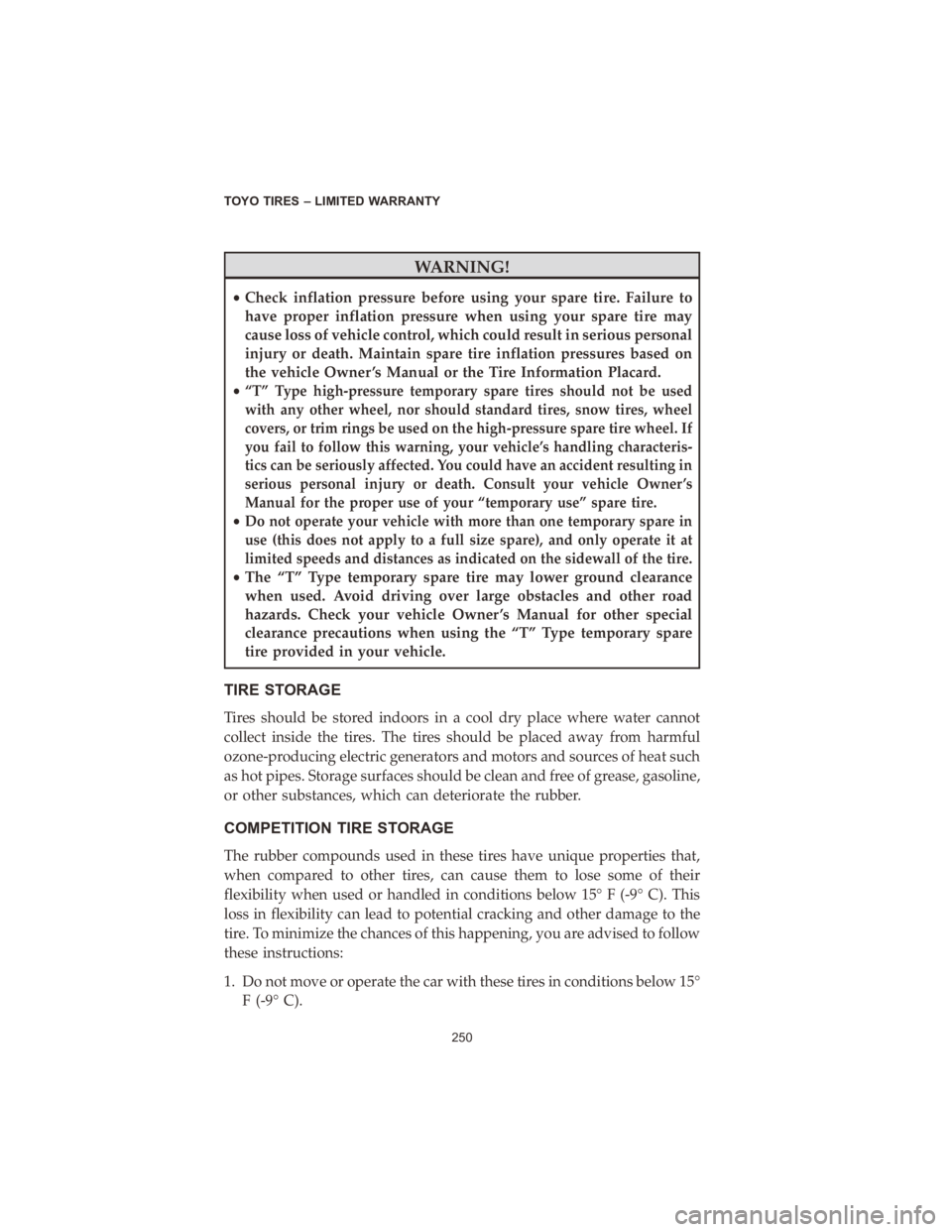
WARNING!
•Check inflation pressure before using your spare tire. Failure to
have proper inflation pressure when using your spare tire may
cause loss of vehicle control, which could result in serious personal
injury or death. Maintain spare tire inflation pressures based on
the vehicle Owner ’s Manual or the Tire Information Placard.
•
“T” Type high-pressure temporary spare tires should not be used
with any other wheel, nor should standard tires, snow tires, wheel
covers, or trim rings be used on the high-pressure spare tire wheel. If
you fail to follow this warning, your vehicle’s handling characteris-
tics can be seriously affected. You could have an accident resulting in
serious personal injury or death. Consult your vehicle Owner ’s
Manual for the proper use of your “temporary use” spare tire.
•Do not operate your vehicle with more than one temporary spare in
use (this does not apply to a full size spare), and only operate it at
limited speeds and distances as indicated on the sidewall of the tire.
• The “T” Type temporary spare tire may lower ground clearance
when used. Avoid driving over large obstacles and other road
hazards. Check your vehicle Owner ’s Manual for other special
clearance precautions when using the “T” Type temporary spare
tire provided in your vehicle.
TIRE STORAGE
Tires should be stored indoors in a cool dry place where water cannot
collect inside the tires. The tires should be placed away from harmful
ozone-producing electric generators and motors and sources of heat such
as hot pipes. Storage surfaces should be clean and free of grease, gasoline,
or other substances, which can deteriorate the rubber.
COMPETITION TIRE STORAGE
The rubber compounds used in these tires have unique properties that,
when compared to other tires, can cause them to lose some of their
flexibility when used or handled in conditions below 15° F (-9° C). This
loss in flexibility can lead to potential cracking and other damage to the
tire. To minimize the chances of this happening, you are advised to follow
these instructions:
1. Do not move or operate the car with these tires in conditions below 15°
F (-9° C).
TOYO TIRES – LIMITED WARRANTY
250
Page 252 of 270
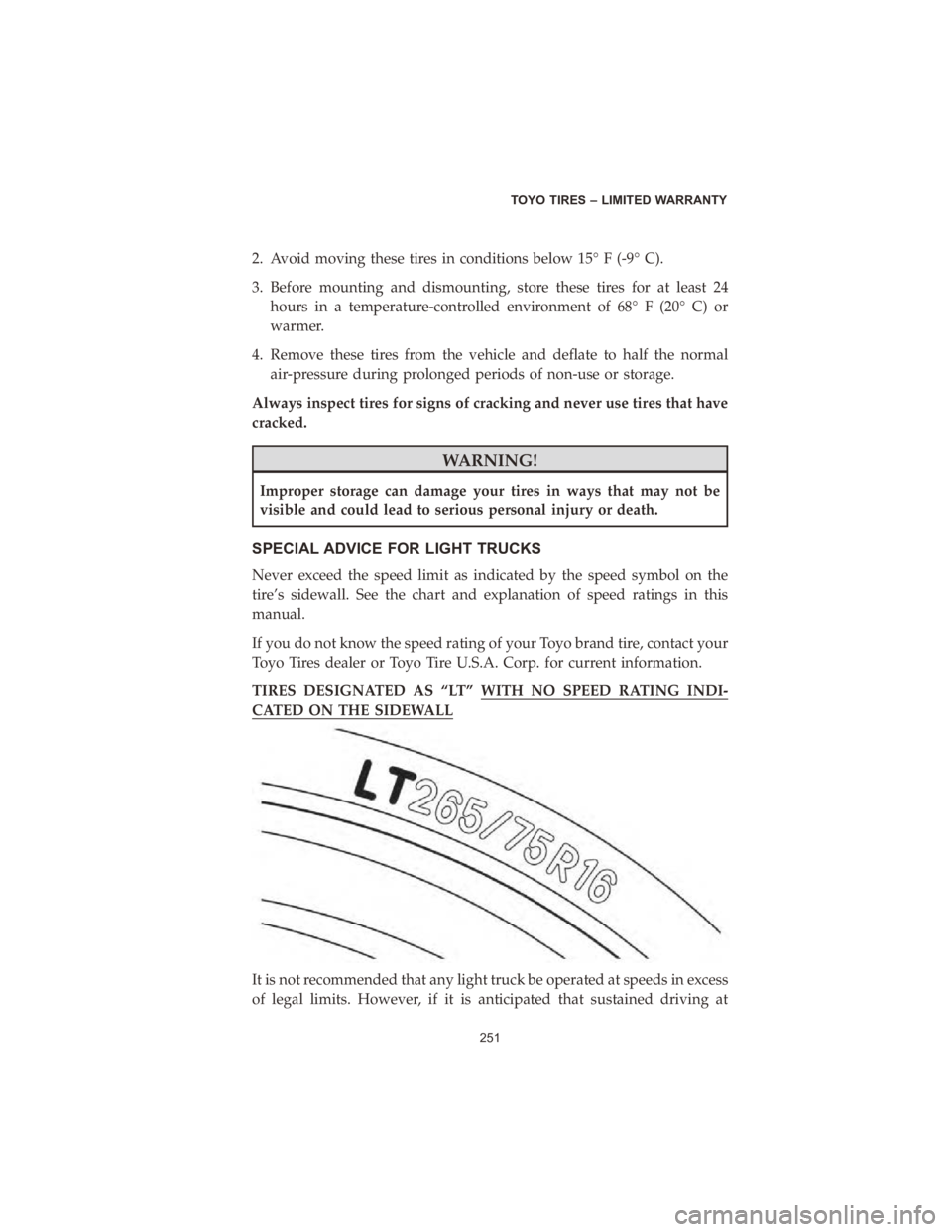
2. Avoid moving these tires in conditions below 15° F (-9° C).
3. Before mounting and dismounting, store these tires for at least 24hours in a temperature-controlled environment of 68° F (20° C) or
warmer.
4. Remove these tires from the vehicle and deflate to half the normal air-pressure during prolonged periods of non-use or storage.
Always inspect tires for signs of cracking and never use tires that have
cracked.
WARNING!
Improper storage can damage your tires in ways that may not be
visible and could lead to serious personal injury or death.
SPECIAL ADVICE FOR LIGHT TRUCKS
Never exceed the speed limit as indicated by the speed symbol on the
tire’s sidewall. See the chart and explanation of speed ratings in this
manual.
If you do not know the speed rating of your Toyo brand tire, contact your
Toyo Tires dealer or Toyo Tire U.S.A. Corp. for current information.
TIRES DESIGNATED AS “LT” WITH NO SPEED RATING INDI-
CATED ON THE SIDEWALL
It is not recommended that any light truck be operated at speeds in excess
of legal limits. However, if it is anticipated that sustained driving at
TOYO TIRES – LIMITED WARRANTY
251
Page 253 of 270
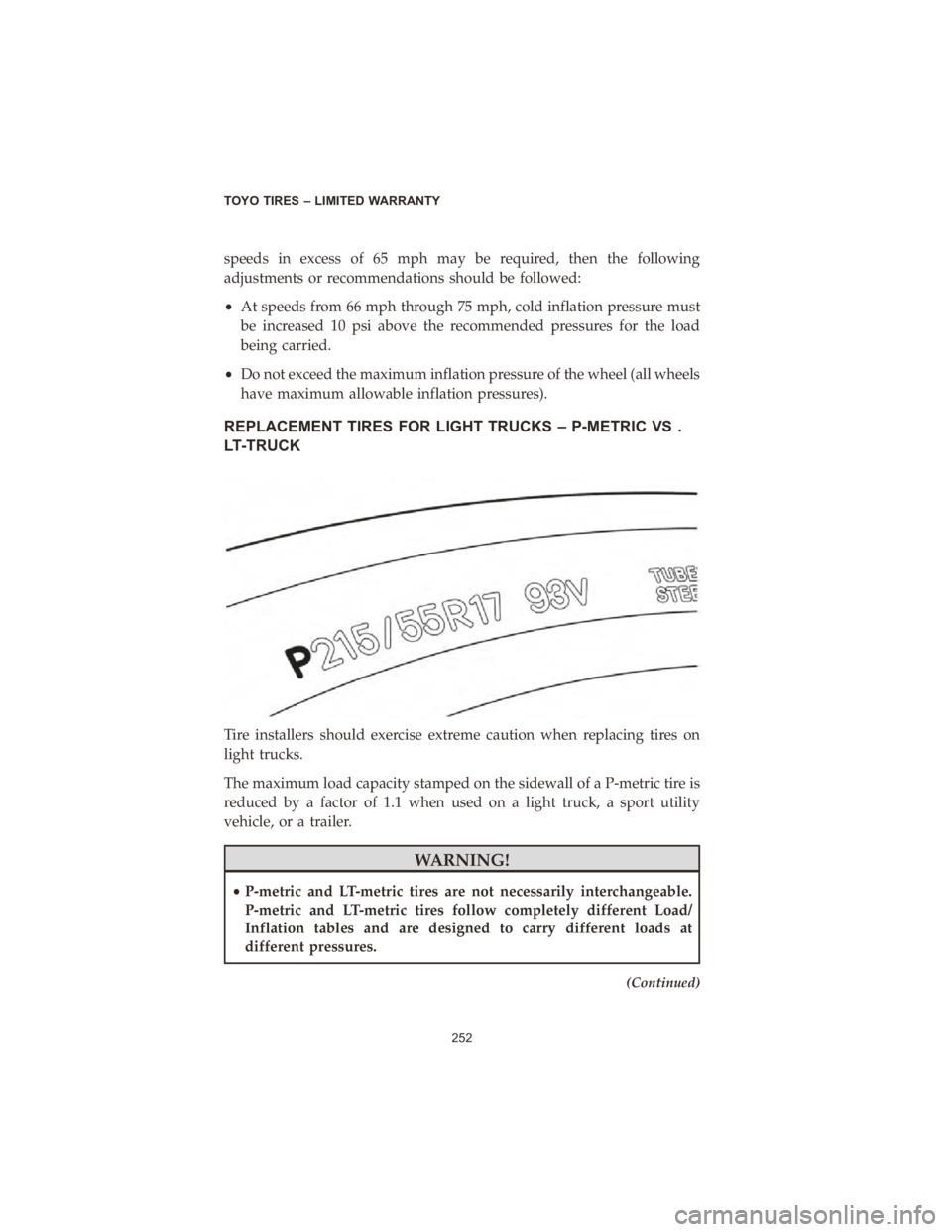
speeds in excess of 65 mph may be required, then the following
adjustments or recommendations should be followed:
•At speeds from 66 mph through 75 mph, cold inflation pressure must
be increased 10 psi above the recommended pressures for the load
being carried.
• Do not exceed the maximum inflation pressure of the wheel (all wheels
have maximum allowable inflation pressures).
REPLACEMENT TIRES FOR LIGHT TRUCKS – P-METRIC VS .
LT-TRUCK
Tire installers should exercise extreme caution when replacing tires on
light trucks.
The maximum load capacity stamped on the sidewall of a P-metric tire is
reduced by a factor of 1.1 when used on a light truck, a sport utility
vehicle, or a trailer.
WARNING!
•P-metric and LT-metric tires are not necessarily interchangeable.
P-metric and LT-metric tires follow completely different Load/
Inflation tables and are designed to carry different loads at
different pressures.
(Continued)
TOYO TIRES – LIMITED WARRANTY
252
Page 254 of 270
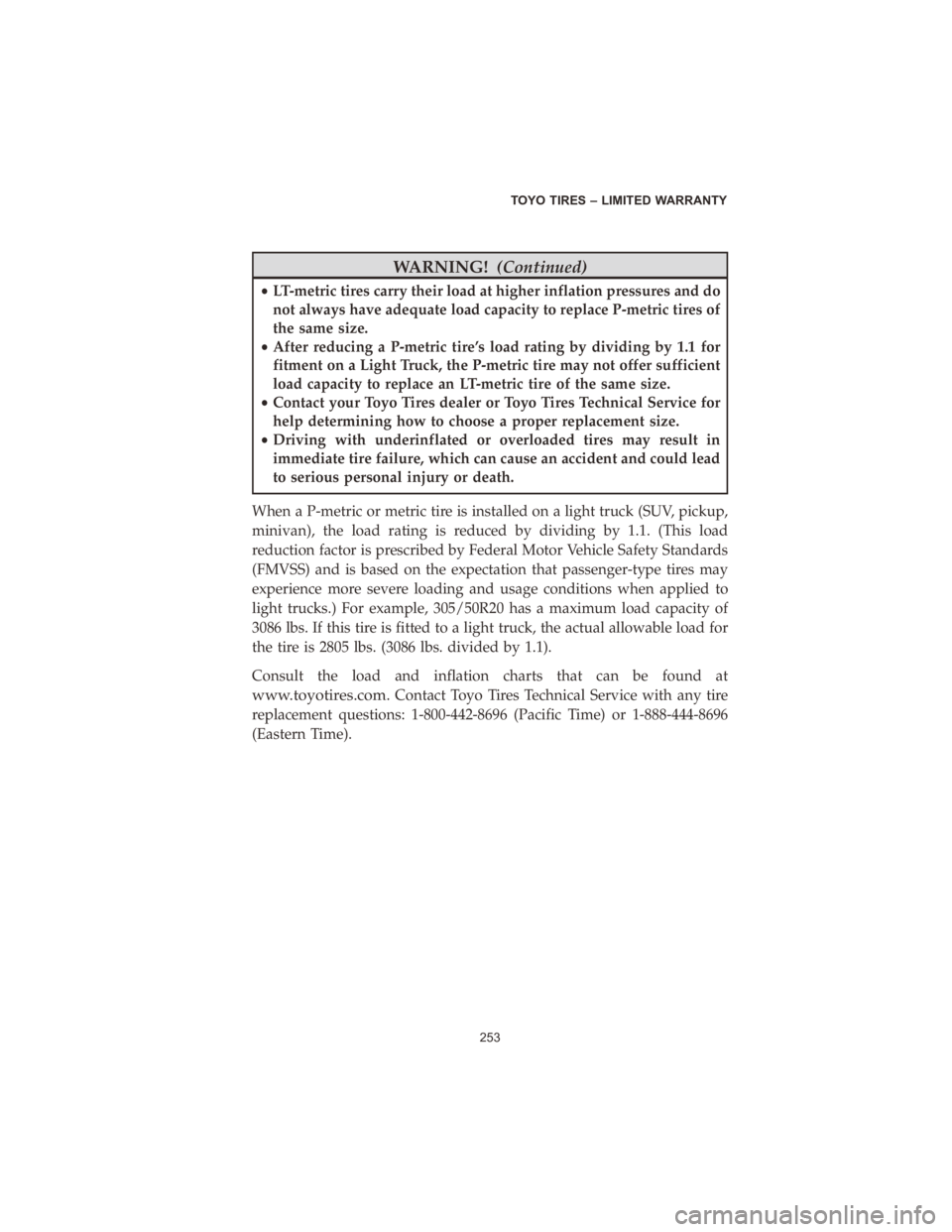
WARNING!(Continued)
•LT-metric tires carry their load at higher inflation pressures and do
not always have adequate load capacity to replace P-metric tires of
the same size.
• After reducing a P-metric tire’s load rating by dividing by 1.1 for
fitment on a Light Truck, the P-metric tire may not offer sufficient
load capacity to replace an LT-metric tire of the same size.
• Contact your Toyo Tires dealer or Toyo Tires Technical Service for
help determining how to choose a proper replacement size.
• Driving with underinflated or overloaded tires may result in
immediate tire failure, which can cause an accident and could lead
to serious personal injury or death.
When a P-metric or metric tire is installed on a light truck (SUV, pickup,
minivan), the load rating is reduced by dividing by 1.1. (This load
reduction factor is prescribed by Federal Motor Vehicle Safety Standards
(FMVSS) and is based on the expectation that passenger-type tires may
experience more severe loading and usage conditions when applied to
light trucks.) For example, 305/50R20 has a maximum load capacity of
3086 lbs. If this tire is fitted to a light truck, the actual allowable load for
the tire is 2805 lbs. (3086 lbs. divided by 1.1).
Consult the load and inflation charts that can be found at
www.toyotires.com. Contact Toyo Tires Technical Service with any tire
replacement questions: 1-800-442-8696 (Pacific Time) or 1-888-444-8696
(Eastern Time).
TOYO TIRES – LIMITED WARRANTY
253
Page 255 of 270
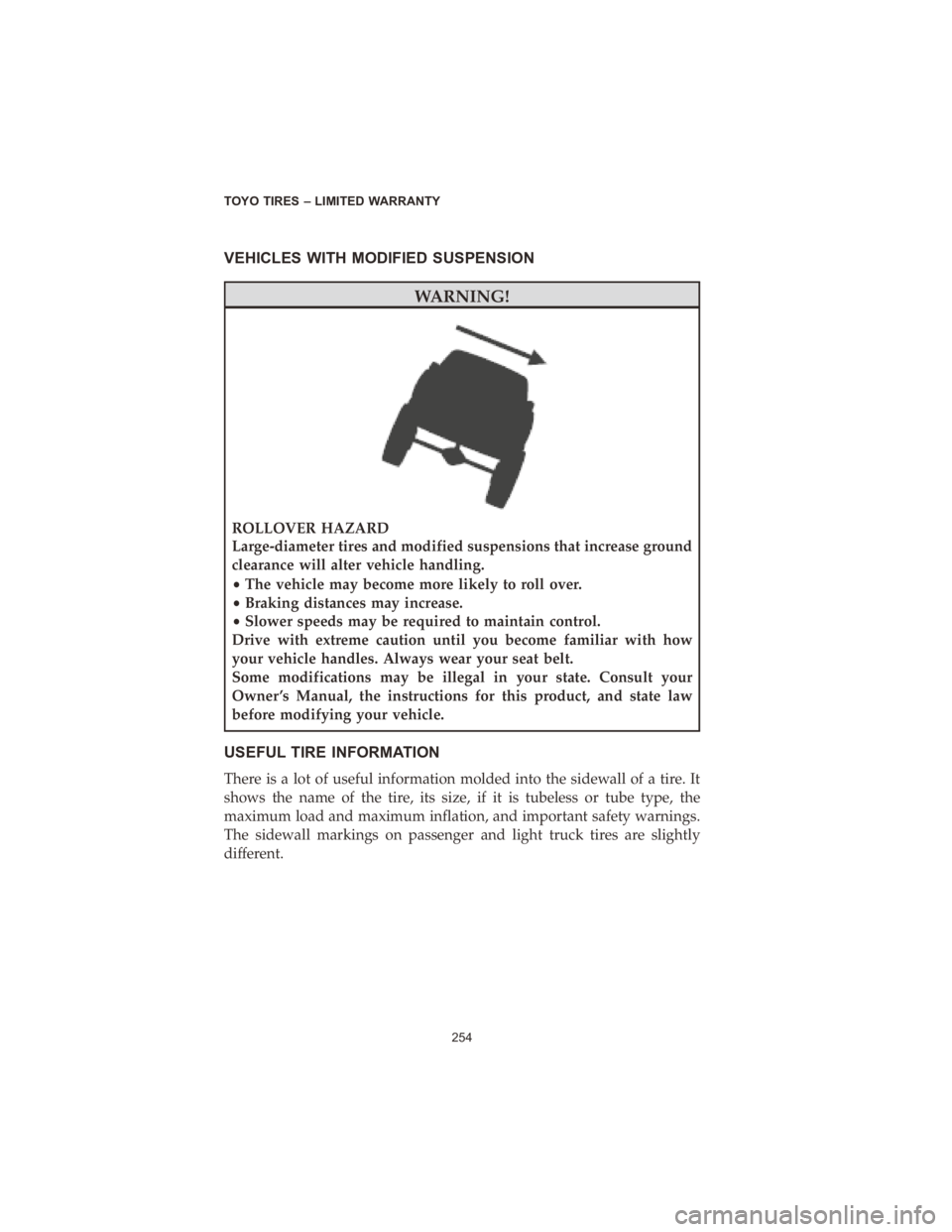
VEHICLES WITH MODIFIED SUSPENSION
WARNING!
ROLLOVER HAZARD
Large-diameter tires and modified suspensions that increase ground
clearance will alter vehicle handling.
•The vehicle may become more likely to roll over.
• Braking distances may increase.
• Slower speeds may be required to maintain control.
Drive with extreme caution until you become familiar with how
your vehicle handles. Always wear your seat belt.
Some modifications may be illegal in your state. Consult your
Owner ’s Manual, the instructions for this product, and state law
before modifying your vehicle.
USEFUL TIRE INFORMATION
There is a lot of useful information molded into the sidewall of a tire. It
shows the name of the tire, its size, if it is tubeless or tube type, the
maximum load and maximum inflation, and important safety warnings.
The sidewall markings on passenger and light truck tires are slightly
different.
TOYO TIRES – LIMITED WARRANTY
254
Page 256 of 270
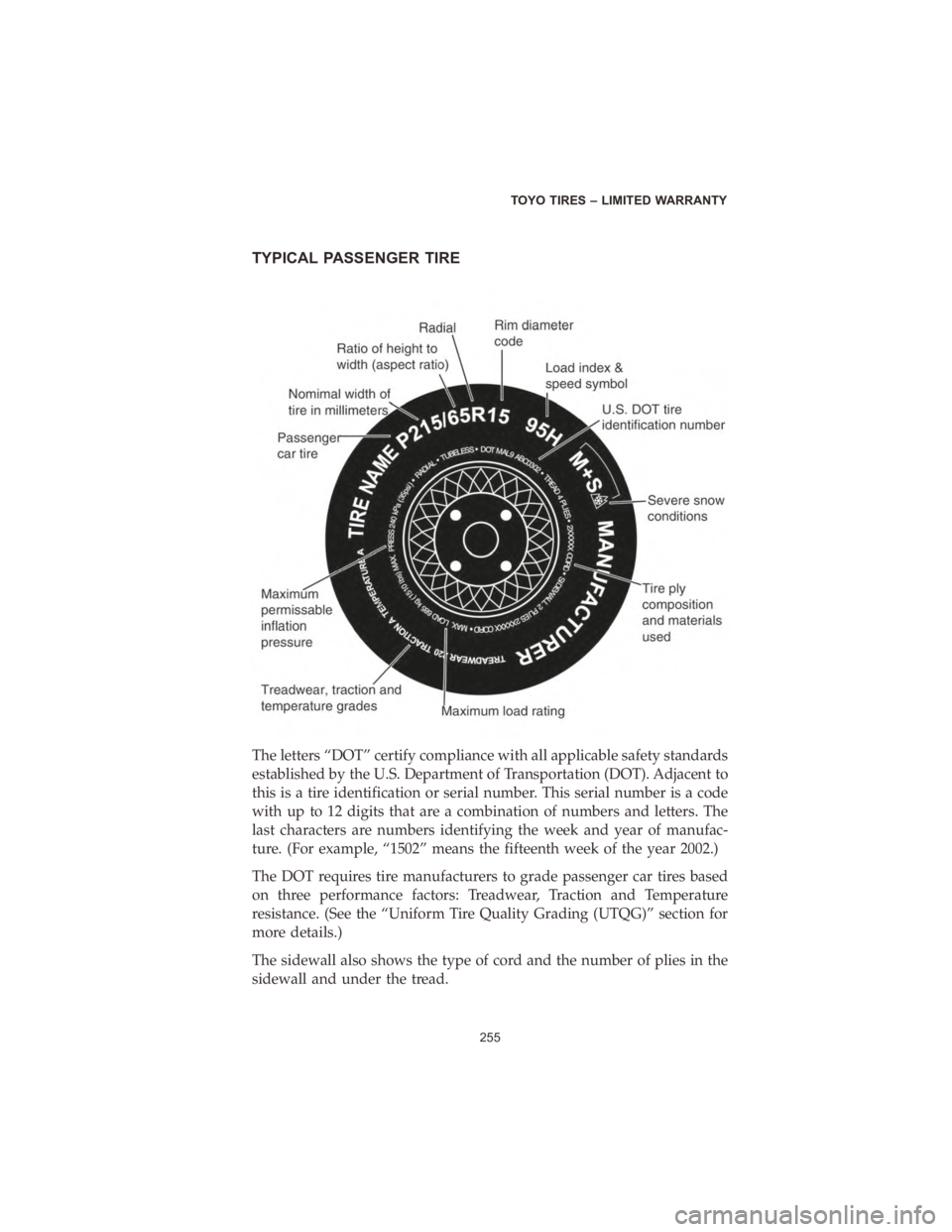
TYPICAL PASSENGER TIRE
The letters “DOT” certify compliance with all applicable safety standards
established by the U.S. Department of Transportation (DOT). Adjacent to
this is a tire identification or serial number. This serial number is a code
with up to 12 digits that are a combination of numbers and letters. The
last characters are numbers identifying the week and year of manufac-
ture. (For example, “1502” means the fifteenth week of the year 2002.)
The DOT requires tire manufacturers to grade passenger car tires based
on three performance factors: Treadwear, Traction and Temperature
resistance. (See the “Uniform Tire Quality Grading (UTQG)” section for
more details.)
The sidewall also shows the type of cord and the number of plies in the
sidewall and under the tread.
TOYO TIRES – LIMITED WARRANTY
255
Page 257 of 270
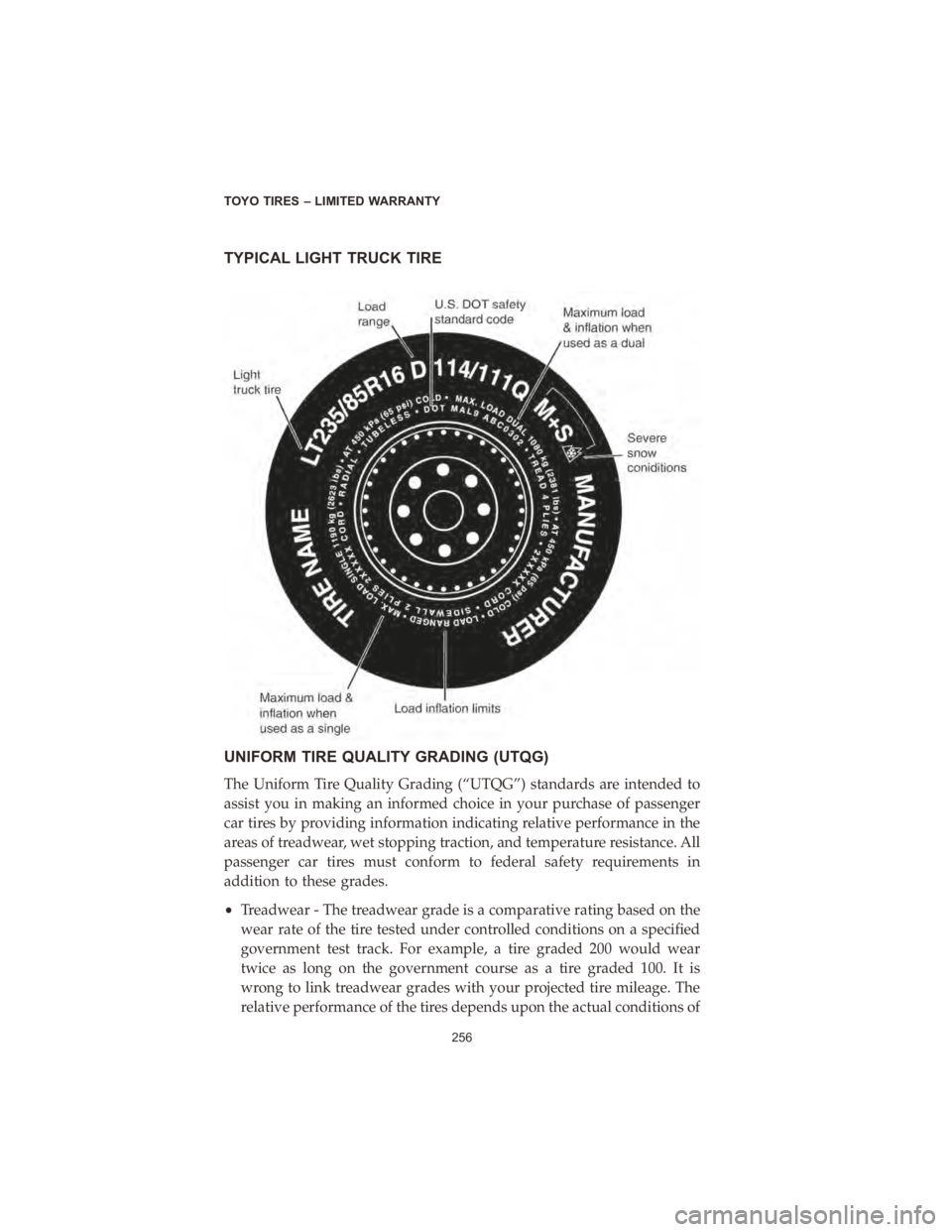
TYPICAL LIGHT TRUCK TIRE
UNIFORM TIRE QUALITY GRADING (UTQG)
The Uniform Tire Quality Grading (“UTQG”) standards are intended to
assist you in making an informed choice in your purchase of passenger
car tires by providing information indicating relative performance in the
areas of treadwear, wet stopping traction, and temperature resistance. All
passenger car tires must conform to federal safety requirements in
addition to these grades.
•Treadwear - The treadwear grade is a comparative rating based on the
wear rate of the tire tested under controlled conditions on a specified
government test track. For example, a tire graded 200 would wear
twice as long on the government course as a tire graded 100. It is
wrong to link treadwear grades with your projected tire mileage. The
relative performance of the tires depends upon the actual conditions of
TOYO TIRES – LIMITED WARRANTY
256
Page 258 of 270
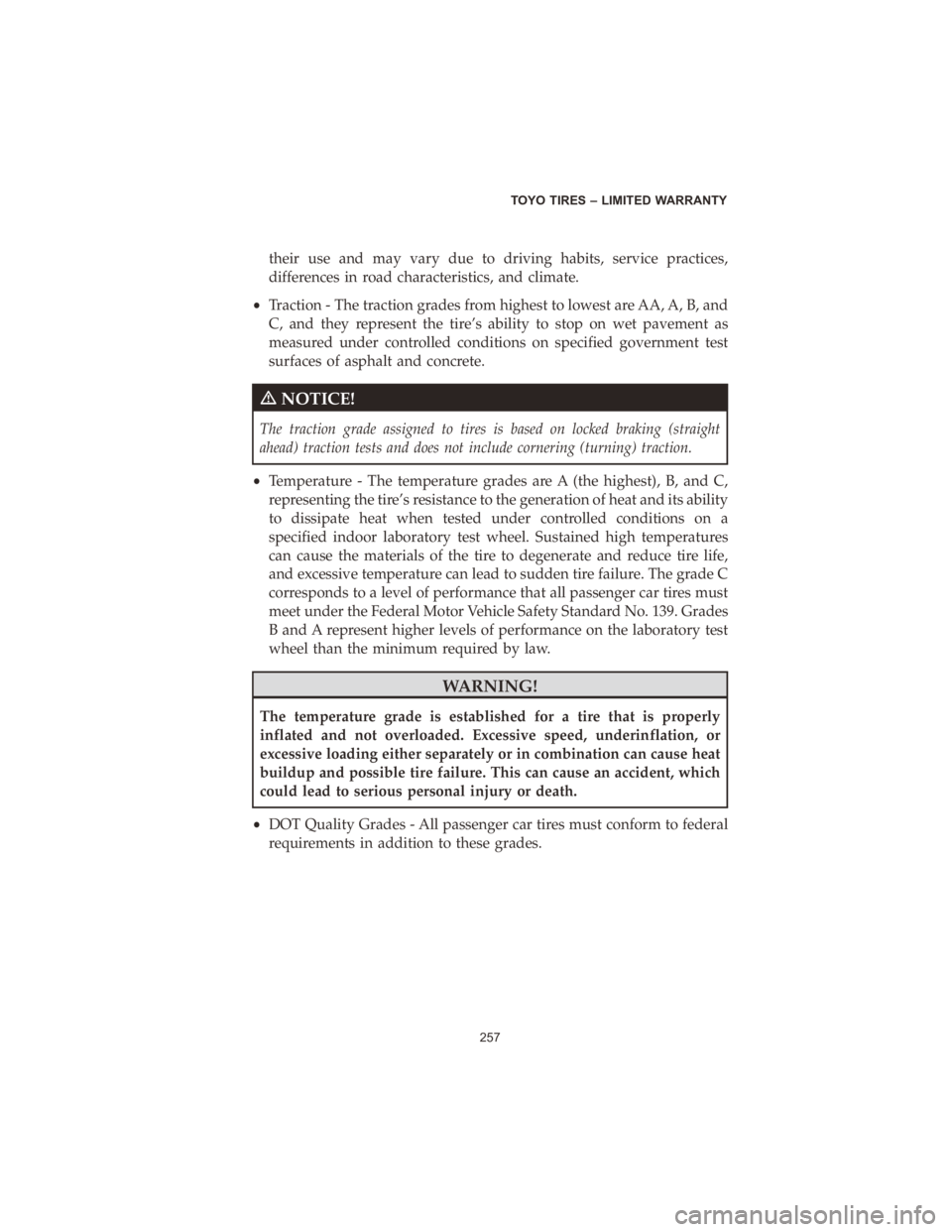
their use and may vary due to driving habits, service practices,
differences in road characteristics, and climate.
• Traction - The traction grades from highest to lowest are AA, A, B, and
C, and they represent the tire’s ability to stop on wet pavement as
measured under controlled conditions on specified government test
surfaces of asphalt and concrete.
m NOTICE!
The traction grade assigned to tires is based on locked braking (straight
ahead) traction tests and does not include cornering (turning) traction.
• Temperature - The temperature grades are A (the highest), B, and C,
representing the tire’s resistance to the generation of heat and its ability
to dissipate heat when tested under controlled conditions on a
specified indoor laboratory test wheel. Sustained high temperatures
can cause the materials of the tire to degenerate and reduce tire life,
and excessive temperature can lead to sudden tire failure. The grade C
corresponds to a level of performance that all passenger car tires must
meet under the Federal Motor Vehicle Safety Standard No. 139. Grades
B and A represent higher levels of performance on the laboratory test
wheel than the minimum required by law.
WARNING!
The temperature grade is established for a tire that is properly
inflated and not overloaded. Excessive speed, underinflation, or
excessive loading either separately or in combination can cause heat
buildup and possible tire failure. This can cause an accident, which
could lead to serious personal injury or death.
• DOT Quality Grades - All passenger car tires must conform to federal
requirements in addition to these grades.
TOYO TIRES – LIMITED WARRANTY
257
Page 259 of 270
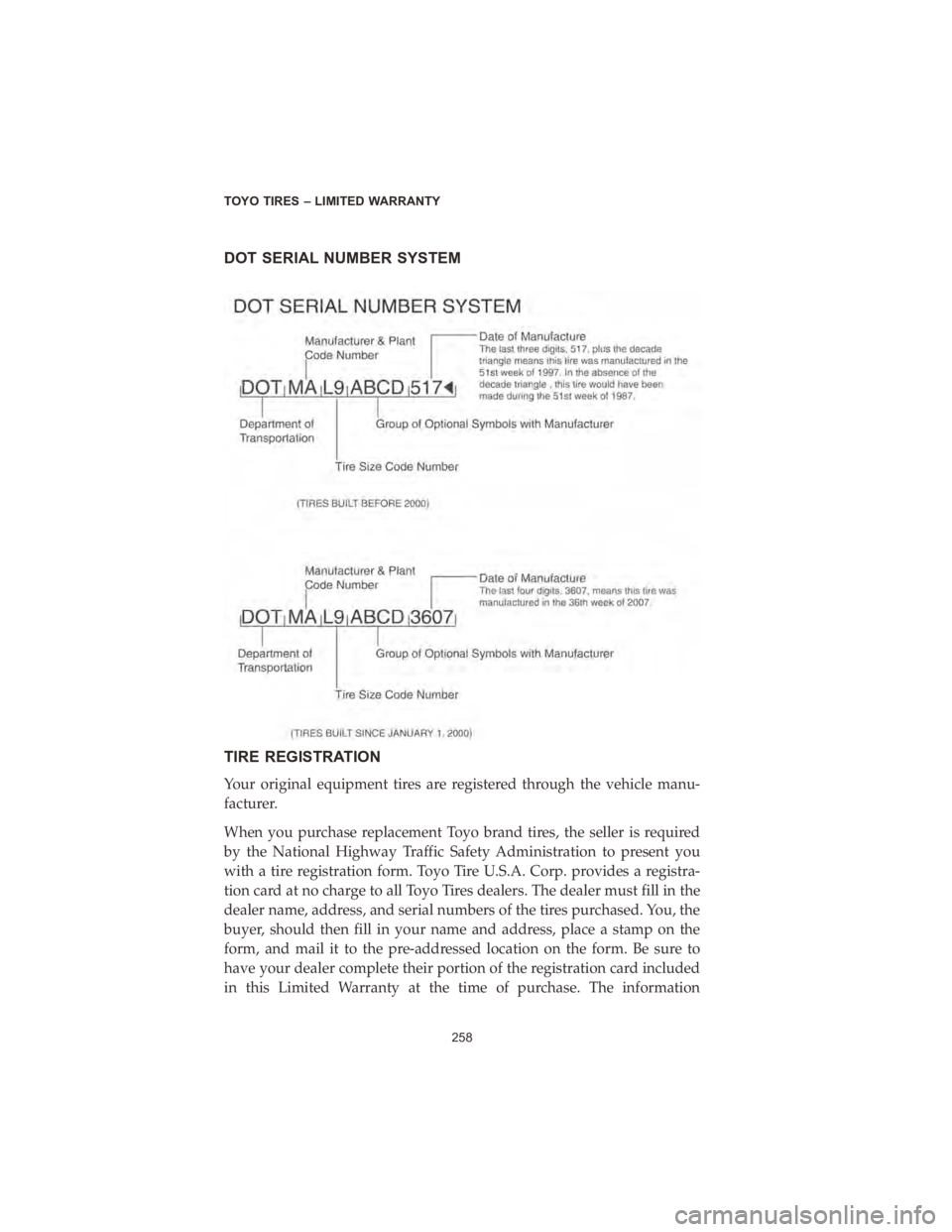
DOT SERIAL NUMBER SYSTEM
TIRE REGISTRATION
Your original equipment tires are registered through the vehicle manu-
facturer.
When you purchase replacement Toyo brand tires, the seller is required
by the National Highway Traffic Safety Administration to present you
with a tire registration form. Toyo Tire U.S.A. Corp. provides a registra-
tion card at no charge to all Toyo Tires dealers. The dealer must fill in the
dealer name, address, and serial numbers of the tires purchased. You, the
buyer, should then fill in your name and address, place a stamp on the
form, and mail it to the pre-addressed location on the form. Be sure to
have your dealer complete their portion of the registration card included
in this Limited Warranty at the time of purchase. The information
TOYO TIRES – LIMITED WARRANTY258
Page 260 of 270
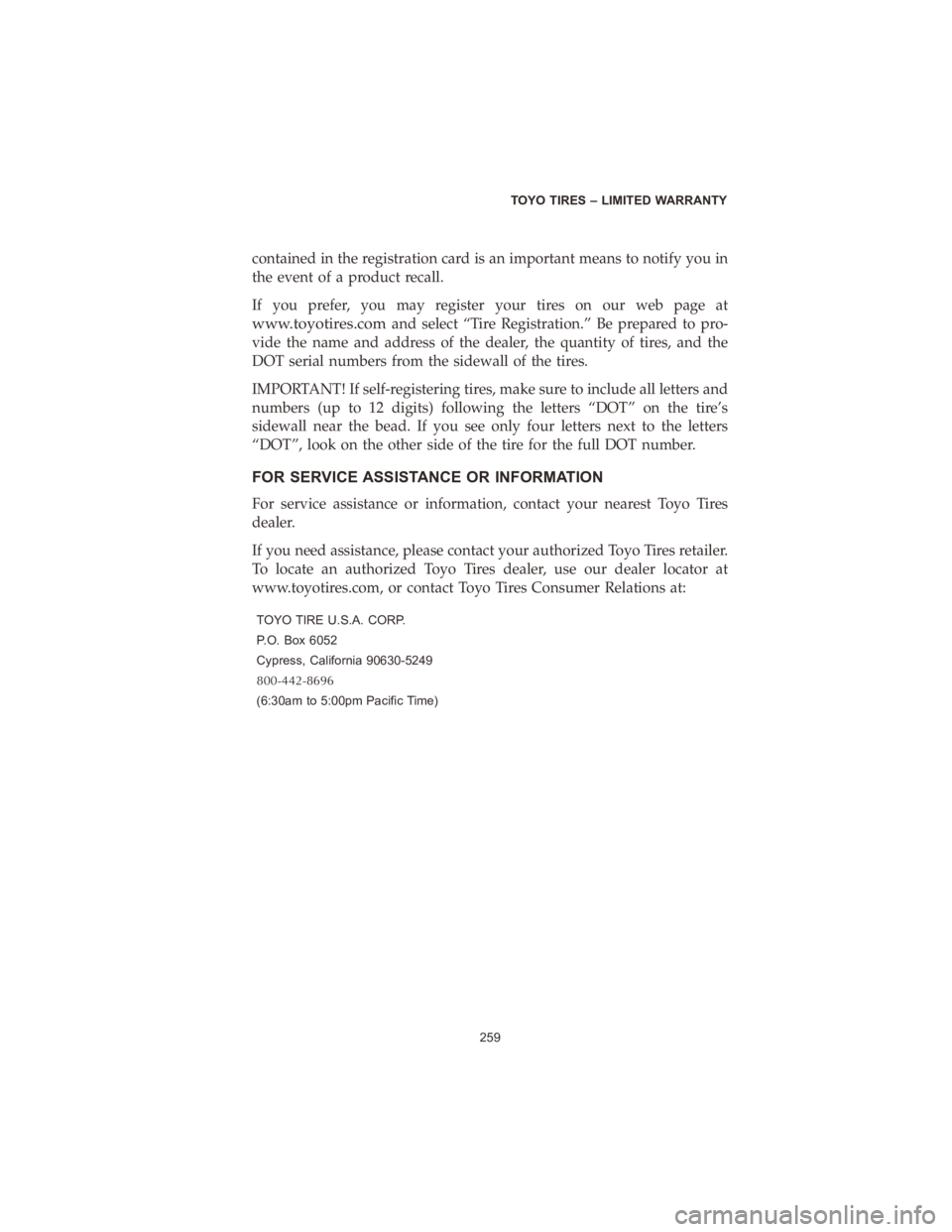
contained in the registration card is an important means to notify you in
the event of a product recall.
If you prefer, you may register your tires on our web page at
www.toyotires.comand select “Tire Registration.” Be prepared to pro-
vide the name and address of the dealer, the quantity of tires, and the
DOT serial numbers from the sidewall of the tires.
IMPORTANT! If self-registering tires, make sure to include all letters and
numbers (up to 12 digits) following the letters “DOT” on the tire’s
sidewall near the bead. If you see only four letters next to the letters
“DOT”, look on the other side of the tire for the full DOT number.
FOR SERVICE ASSISTANCE OR INFORMATION
For service assistance or information, contact your nearest Toyo Tires
dealer.
If you need assistance, please contact your authorized Toyo Tires retailer.
To locate an authorized Toyo Tires dealer, use our dealer locator at
www.toyotires.com, or contact Toyo Tires Consumer Relations at:
TOYO TIRE U.S.A. CORP.
P.O. Box 6052
Cypress, California 90630-5249
800-442-8696
(6:30am to 5:00pm Pacific Time) TOYO TIRES – LIMITED WARRANTY
259